Below are some pictures of adding refrigerant to a 2000 crown victoria.
This car recently had some air conditioning system service work done
and it is completely empty of refrigerant. Factory specifications call
for 38oz of r134a refrigerant, but 3 12oz cans of r134a should be
sufficent to get the system working again.
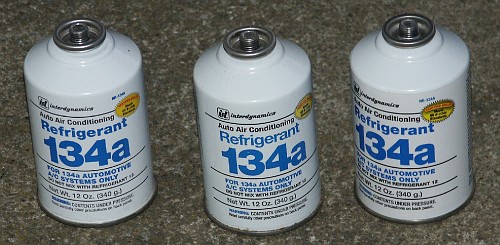
Here's an empty refrigerant can with charging hose attached for
illustration purposes
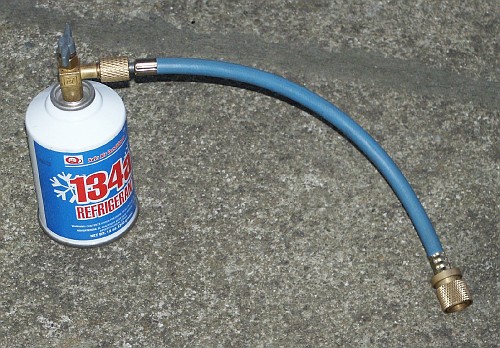
Notice the hole pierced in the top of the can from the can tap.
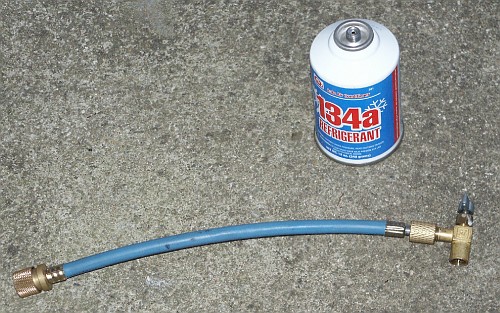
The charge port on the 1992-2002 crownvics is on the low side suction
accumulator.
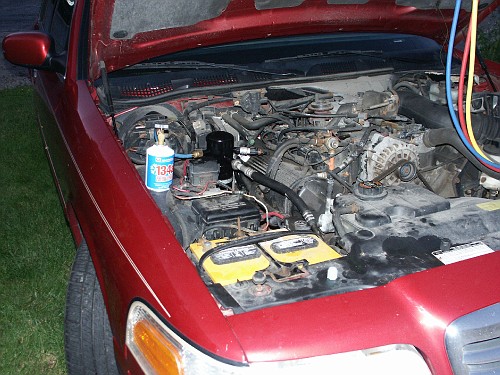
Although not shown, I usually boil a plastic container of water in the
microwave and partially submerge the can of r134a refrigerant in the
water during the recharge procedure. This helps get all the refrigerant
out of the can during the recharge. It's obvious that there is heat
transfer going on because the hot water will become cold to the touch
when the refrigerant can becomes empty.
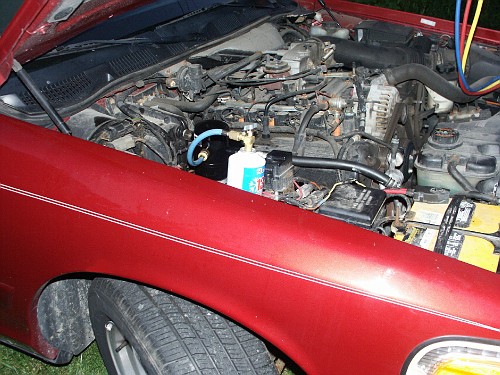
Be warned that the can of refrigerant will become very cold as the
car's a/c system is being recharged. So you will want to wear a thick
set of insulated winter gloves to prevent your skin from getting
frostbite.
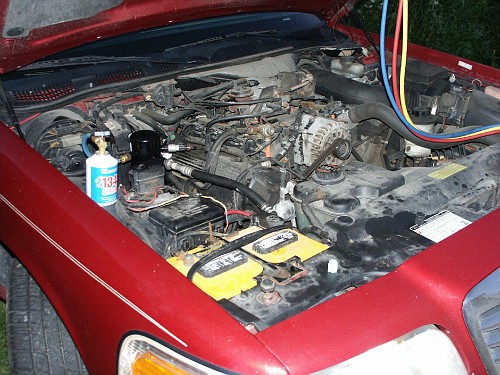
The a/c system is currently under 29mm of vacuum, so the a/c cycle
switch is going to have to be jumpered to get the compressor clutch to
enagage.
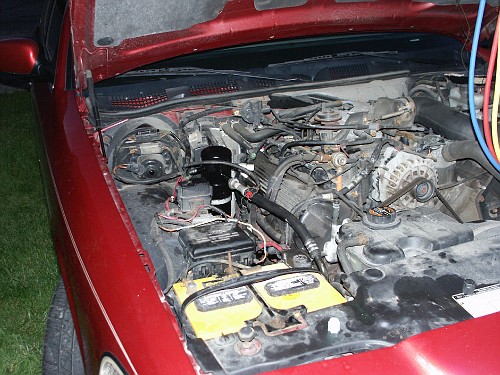
You might want to use something other than an exposed bent paperclip to
jumper the a/c cycle switch in case it accidentally contacts the metal
chassis of the car

Now that the 3 cans of refrigerant have been added, a manifold guage
set is connected to the system.
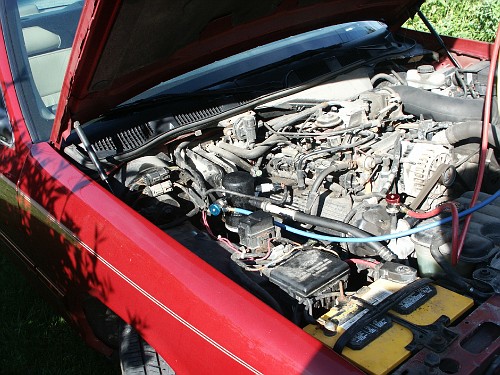
The accumulator is sweating nicely from condensing water in the ambient
air
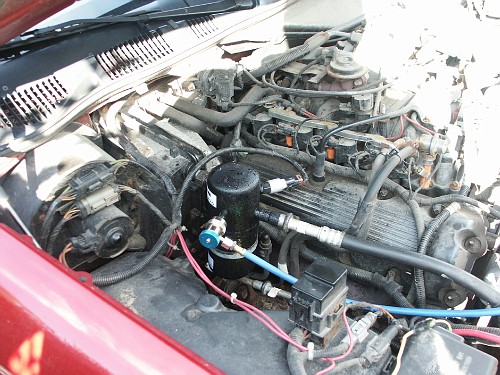
The metal end of the suction hose near the compressor is also sweating
from condensing water from the ambient air.
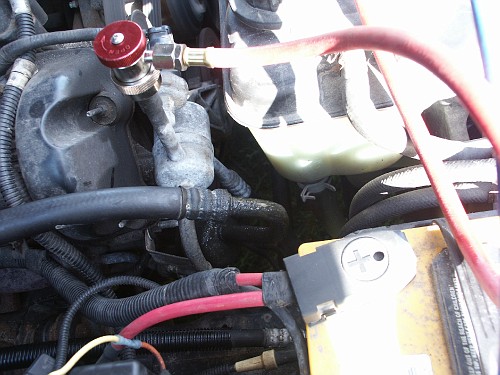
When service guage connector was removed from the accumulator, some
refrigerant and oil escaped. Ford uses factory green tracer dye in
their a/c systems that you can see below. Looks almost like antifreeze
at a quick glance.
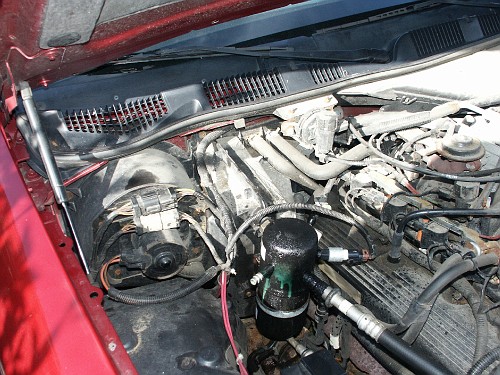
The r134a refrigerant fill procedure was successful and the air
conditioning system in the car now blows cold. However, the highside
head pressure was 310 psi on a 75 degree day. But this
reading fell to 250psi on a 80 degree day after cleaning debris
from the condensor and evaporator with water from a garden hose. The
discharge readings are still a little high, but not so high that the
refrigerant lubricants will break down in the relatively mild ambient
temperatures of a northeastern united states summer.
After the refill, there was ice sometimes forming on the outside of the
evaporator and accumulator. This shows that compressor is creating a
good pressure differential between the suction and discharge ports, but
unfortunately minimal air flows through an evaporator that has turned
into a solid chunk of ice. So a new aftermarket four seasons low
pressure cutoff switch was installed, and the ice has disappeared for
the most part. The new switch cuts the compressor out at a slightly
higher pressure on the low end, and leaves the compressor disengaged
until the pressure builds to a slightly higher pressure than the old
switch did.
The a/c system now seemed to be working good when taking short trips
around town with mild ambient temperatures. When a longer trip was
taken on the highway during 90 degree weather, the a/c system started
to blow warm air though. Further investigation revealed cracks in the
rubber insulators on the front compressor clutch plate and some
discoloration of the compressor clutch metal from high heat. These
symptoms pointed to a clutch that was slipping during high load
conditions. So a shim washer was removed from the clutch and the clutch
seemed to be holding good during high load conditions. Some surface
wear of the clutch plates is normal on older cars. However, if so much
heat is generated during clutch slippage that the grease boils out of
the clutch bearing, then a new compressor will need to be installed.
Finally, the a/c system seems to work acceptably. The car could use a
new compressor due to clutch wear and a slight shaft seal leak. The
condensor is somewhat corroded from being blasted with chloride road
salts and sand during the winter months causing reduced heat transfer
capabilities. The two hoses that connect to the condensor have visible
corrosion around the connection points to the condensor, though the
connection points don't seem to leak noticeable amounts of refigerant
at the moment. The electric condensor/radiator fan seems to be spinning
a little slower than the 1998 crownvic that has a new fan motor
installed. However, the a/c blows cold and the car can likely be driven
for a while without replacing any additional parts in the near future.
This is not a new car that just rolled off the dealership's showroom
floor yesterday, but rather a ~10 year old car that has been driven
over 100k miles. Also, the car lives in the northeast where ambient
temperatures during the summer are relatively mild compared to much of
the country.











